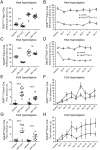VGLUT2 controls heat and punctuate hyperalgesia associated with nerve injury via TRPV1-Cre primary afferents
- PMID: 25615623
- PMCID: PMC4304805
- DOI: 10.1371/journal.pone.0116568
VGLUT2 controls heat and punctuate hyperalgesia associated with nerve injury via TRPV1-Cre primary afferents
Abstract
Nerve injury induces a state of prolonged thermal and mechanical hypersensitivity in the innervated area, causing distress in affected individuals. Nerve injury-induced hypersensitivity is partially due to increased activity and thereby sustained release of neurotransmitters from the injured fibers. Glutamate, a prominent neurotransmitter in primary afferents, plays a major role in development of hypersensitivity. Glutamate is packed in vesicles by vesicular glutamate transporters (VGLUTs) to enable controlled release upon depolarization. While a role for peripheral VGLUTs in nerve injury-induced pain is established, their contribution in specific peripheral neuronal populations is unresolved. We investigated the role of VGLUT2, expressed by transient receptor potential vanilloid (TRPV1) fibers, in nerve injury-induced hypersensitivity. Our data shows that removal of Vglut2 from Trpv1-Cre neurons using transgenic mice abolished both heat and punctuate hyperalgesia associated with nerve injury. In contrast, the development of cold hypersensitivity after nerve injury was unaltered. Here, we show that, VGLUT2-mediated glutamatergic transmission from Trpv1-Cre neurons selectively mediates heat and mechanical hypersensitivity associated with nerve injury. Our data clarifies the role of the Trpv1-Cre population and the dependence of VGLUT2-mediated glutamatergic transmission in nerve injury-induced hyperalgesia.
Conflict of interest statement
Figures




Similar articles
-
VGLUTs and Glutamate Synthesis-Focus on DRG Neurons and Pain.Biomolecules. 2015 Dec 2;5(4):3416-37. doi: 10.3390/biom5043416. Biomolecules. 2015. PMID: 26633536 Free PMC article. Review.
-
Glutamate, substance P, and calcitonin gene-related peptide cooperate in inflammation-induced heat hyperalgesia.Mol Pharmacol. 2014 Feb;85(2):322-34. doi: 10.1124/mol.113.089532. Epub 2013 Nov 25. Mol Pharmacol. 2014. PMID: 24275230
-
VGLUT2 expression in primary afferent neurons is essential for normal acute pain and injury-induced heat hypersensitivity.Proc Natl Acad Sci U S A. 2010 Dec 21;107(51):22296-301. doi: 10.1073/pnas.1013413108. Epub 2010 Dec 6. Proc Natl Acad Sci U S A. 2010. PMID: 21135246 Free PMC article.
-
mTOR signaling controls VGLUT2 expression to maintain pain hypersensitivity after tissue injury.Neuroscience. 2015 Nov 12;308:169-79. doi: 10.1016/j.neuroscience.2015.09.013. Epub 2015 Sep 8. Neuroscience. 2015. PMID: 26362885
-
VGLUTs in Peripheral Neurons and the Spinal Cord: Time for a Review.ISRN Neurol. 2013 Nov 20;2013:829753. doi: 10.1155/2013/829753. ISRN Neurol. 2013. PMID: 24349795 Free PMC article. Review.
Cited by
-
Inhibition of the TRPM2 and TRPV1 Channels through Hypericum perforatum in Sciatic Nerve Injury-induced Rats Demonstrates their Key Role in Apoptosis and Mitochondrial Oxidative Stress of Sciatic Nerve and Dorsal Root Ganglion.Front Physiol. 2017 May 31;8:335. doi: 10.3389/fphys.2017.00335. eCollection 2017. Front Physiol. 2017. PMID: 28620309 Free PMC article.
-
VGLUTs and Glutamate Synthesis-Focus on DRG Neurons and Pain.Biomolecules. 2015 Dec 2;5(4):3416-37. doi: 10.3390/biom5043416. Biomolecules. 2015. PMID: 26633536 Free PMC article. Review.
-
Neuroprotective Effect of Nypa fruticans Wurmb by Suppressing TRPV1 Following Sciatic Nerve Crush Injury in a Rat.Nutrients. 2020 Aug 27;12(9):2618. doi: 10.3390/nu12092618. Nutrients. 2020. PMID: 32867278 Free PMC article.
References
Publication types
MeSH terms
Substances
LinkOut - more resources
Full Text Sources
Other Literature Sources
Molecular Biology Databases

